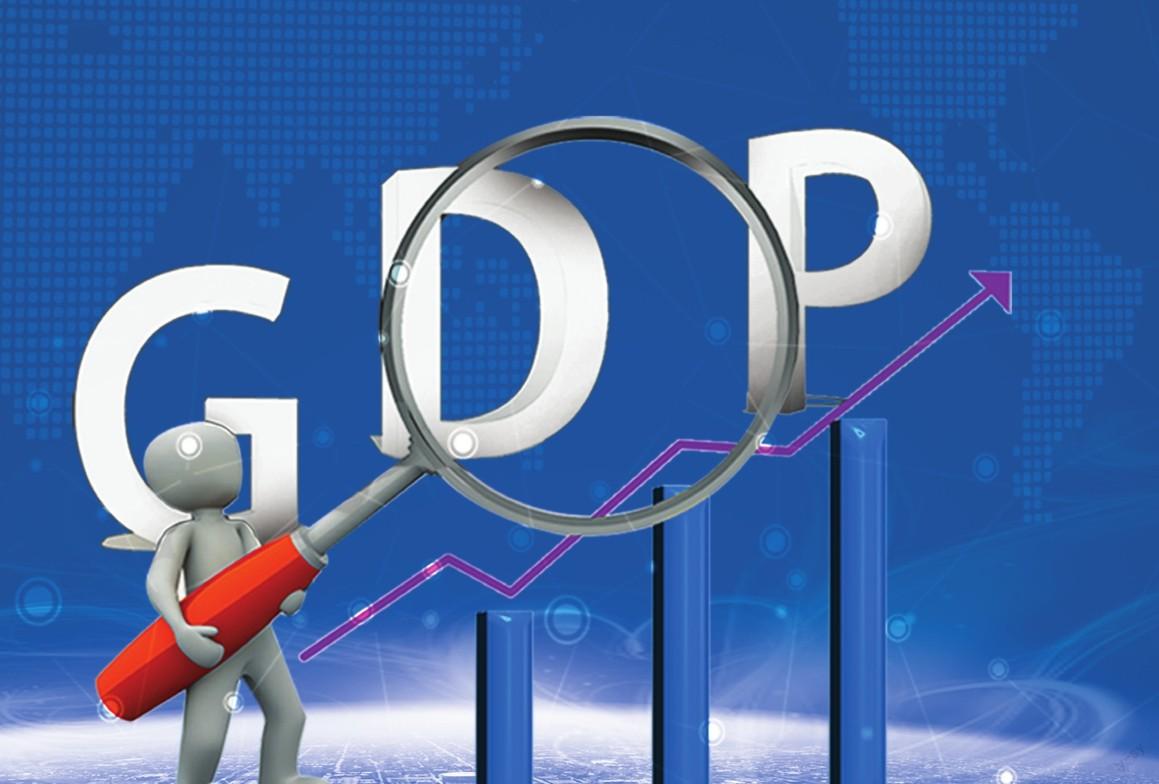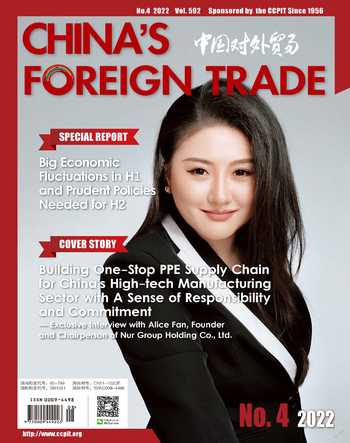Big Economic Fluctuations in H1 and Prudent Policies Needed for H2
By Lily Wang
According to the latest data released by the National Bureau of Statistics, Chinas GDP in the first half of the year reached RMB 56.2642 trillion, an increase of 2.5% year-on-year if calculated using constant prices. If the growth rate is examined by quarter, the GDP increased by 4.8% and 0.4% in Q1 and Q2 respectively, showing large economic fluctuations.
Stabilize market prices and prevent imported inflation
Han Yongwen, Deputy Director of the CCIEE (China Center for International Economic Exchanges), emphasized at the 154th Monthly Economic Talk of CCIEE that if the pandemic does not regain traction in many areas, that discussions about 5% economic growth rate for the whole year would not be misplaced. At present, China is facing some new challenges in stabilizing growth, employment, prices and expanding demand. It has been suggested that China should effectively coordinate and scientifically balance the relationship between pandemic control and economic development, and avoid the discoordination between public health management and economic management. It is important to do everything possible to boost market confidence and consumption, while still attaching great importance to stabilizing market prices, and strictly preventing imported inflation.
Han Yongwen explained that in the first half of the year, Chinas economy has seen both ups and downs. However, the current growth trend is good and positive factors are accumulating. It is believed that with the implementation of a series of policies, an improved result will be seen.
“If the pandemic does not rebound on a large scale, it is expected that the economy will grow markedly. I am confident that we will achieve the 5% economic growth target for the year.”Han Yongwen also said that it is also important to understand that there are still many difficult challenges that may hinder economic recovery. Naturally, the pandemic will be the largest uncertainty to impact economic growth.
Han Yongwen also pointed out that the balance between pandemic control, stabilizing social order and promoting economic development remains uncoordinated and disharmonious. China should carefully re-evaluate the experience and lessons gained over the past three years, scientifically coordinate the dialectical relationship between the pandemic control and economic development, strengthen the overall planning and coordination between public health management departments and macroeconomic decision-making departments, avoid policy inconsistencies, and scientifically use big data technology according to the new characteristics of virus variations and transmission, so as to minimize the negative spillover effect on normal economic operation.
In addition, it is necessary to focus on the constrained consumption caused by the weak market expectations, the lack of export growth momentum due to falling demand in foreign countries, increasing pressure on youth employment and the expectations for price rises.
In terms of boosting market confidence and consumption, Han Yongwen suggested that the offline consumption service industry, which suffered big hits during the pandemic, needs to recover quickly. It is important to support and recover the wholesale, catering, accommodation, cultural and entertainment, travel and other service consumption in an orderly manner, and stabilize the market entities, market consumption and employment channels.
Han praised the role of issuing consumption coupons to stimulate consumption, and suggested making a good summary and promotion of such practices to optimize the structure of issuance and utilization thereof. The central and local governments should give policy subsidies and enable low-income people and impoverished groups to get direct access to the consumption coupons.
Zhu Guangyao, Deputy Director of the CCIEE and former Vice Minister of the Ministry of Finance, said that many factors, including the debt crisis in the international financial market, the global energy crisis and the food crisis, are intertwined, seriously impacting global economic development. He pointed out the need to earnestly implement a package of policies to stabilize the economy, enhance the synergy of fiscal and monetary policies, and effectively deal with the default risk of individual real estate debt. By deepening reform and opening up to the outside world at a high level, it will be possible to accelerate the digital transformation of enterprises, effectively improve the total factor productivity, and ensuring that the fundamentals of Chinas economy remain sound for a long time.
Li Xuesong, Director of the Institute of Quantitative & Technological Economics of the Chinese Academy of Social Sciences and director of the think tank for macroeconomic research, said that the “triple pressure” of shrinking demand, supply shocks and weakening expectations in the first half of the year has not been fundamentally eased. In the second half of the year, the economy may face the challenges of repeated pandemic relapses, falling exports and weak real estate supply and demand. Short-term policies should be combined with medium and long-term strategies, so as to make full use of the “triple structural upgrade” to combat the“triple pressure”. First, it is important to strengthen demand side management, promote the upgrading of the demand structure, and build a strong domestic market; second, furthering the supply side structural reform, promoting the upgrading of the supply structure, and building a modern industrial system; third, deepening reform and opening up, promoting the upgrading of the efficiency structure, and improving the potential for economic growth.
Zhang Yu, assistant to the director of the research institute and chief macroeconomic analyst of Huachuang Securities, said that at present, the risk of U.S. inflation exceeding expectations is still high, which will continue to disturb the global financial market and increase the uncertainty of external demand; due to the sporadic outbreaks of COVID-19, the growth rate of consumption and the total social income has not returned to pre- pandemic levels. In the second half of the year, the policies of stabilizing employment, strengthening the guarantee of peoples livelihood, issuing special policies to support the technological transformation of the manufacturing industry, and promoting the digitalization and green transformation of the manufacturing industry must be earnestly implemented. At the same time, interest rates for housing loans should be appropriately reduced and residents willingness to purchase houses should also be improved. It is important to adhere to a monetary policy that is tailored to Chinas domestic needs, enhance the flexibility of the exchange rate, and give full play to the stabilizing role of exchange rate regulation.
Investment to stabilize growth, while social investment attracts attention
Since early this year, a batch of traditional infrastructural programs in the transportation, energy and hydrogen sectors and new projects such as 5G and data centers have been implemented, and the key projects listed in the “14th Five-Year Plan” have been making further progress. According to data from the National Bureau of Statistics, from January to May, infrastructure investment increased by 6.7% year-onyear, which is 0.5 percentage points higher than the growth rate for all investment, showing the magnetic effect of infrastructure investment. Looking forward to the second half of the year, the market believes that infrastructure investment will continue to increase. Cheng Qiang, chief macroeconomic analyst of CITIC Securities, pointed out that with more effective control over the pandemic, the infrastructure raw material distribution and construction environment have improved, and operations such as project, capital and factor guarantees have become more smooth. It is expected that the infrastructure growth rate will return to a reasonable range of 9-12% from June, and the annual infrastructure investment growth rate is expected to reach 10.1%.
Cheng also believes that fiscal capital is the main contributor to the rapid growth of infrastructure investment this year, and in the downward cycle of economic growth, the government usually faces difficulties in terms of credit expansion and limited fiscal expansion. The government and social capital cooperation (PPP) and real estate investment trust (REITs) can mobilize social capital to invest in infrastructure construction, which constitutes a certain supplement to the source of infrastructure funds.
Regarding project construction in the second half of the year, the National Development and Reform Commission recently re-stressed that it will speed up the construction of a number of water conservancy, transportation, underground integrated pipe gallery and other projects that are beneficial both in the present and the future. Many insiders in the industry told our reporter that the PPP model has not only been applied in water conservancy and transportation projects, but has also played a greater role in underground integrated pipe gallery projects.
Tan Zhiguo, Deputy General Manager of China Investment Consulting Co., Ltd., stressed that compared with other municipal projects, underground comprehensive pipe gallery projects usually feature a larger investment scale, a longer construction cycle, and more complex operation and management. Adopting the PPP mode will focus more on the comprehensive benefits of the whole life cycle of the project; this can reduce the pressures of current fiscal expenditure and smooth long-term fiscal expenditure; and professional management and operation institutions can be introduced to reduce costs and increase the efficiency, and make payments based on performance evaluations.
Underground comprehensive pipe galleries are an important infrastructure type for ensuring normal operation of a city. Some institutions estimate that the market size of national urban comprehensive pipe galleries is expected to exceed RMB 350 billion during the “14th Five-Year Plan” period. At present, local governments have been improving the policies for introducing social capital. Tianjin Housing and Urban-Rural Construction Commission recently issued the Notice on Encouraging and Supporting Social Capital to Participate in the Investment and Construction of Municipal Infrastructure, Urban Renewal and Other Fields. Seven departments including Hebei Housing and Urbanrural Construction Department, Hebei Development and Reform Commission and Hebei Finance Department jointly issued four policies and measures to speed up the construction of municipal infrastructure. The policies particularly mentioned that municipal facilities such as the water supply, gas supply, heating, parking lots, sewage and garbage treatment, affordable rental housing and other assets are preferred for social capital investment. The REITs pilot scheme was announced in the field of infrastructure, as well as the use of the collected funds from asset securitization for the construction of new municipal infrastructure projects.
Economic stabilization policy should balance the present and the future
“There is no need to worry about the stabilization and recovery of the economy in the near future, but we should seize the opportunities provided by both the external and internal environment, and make preparations to solve some deep-seated problems,” said Liu Yuanchun, President of Shanghai University of Finance and Economics when talking about how to overcome difficulties and achieve steady growth in the second half of the year.
“We should not over-use policies due to excessive worry,” said Liu Yuanchun, while explaining that the Q2 data shows the foundation of Chinas economic recovery to be very solid. The main task of the next step is comprehensive recovery, which requires the stimulation of the internal growth momentum of market entities. Therefore, the economic stabilization policy must take into account the present situation and the longterm future. The implementation and transmission of policy measures should also be points of focus.
Liu Yuanchun also said that in the process of transition, it is necessary to continue to focus on large-scale projects, fully stimulate private investment and adjust the market expectations. At the same time, for the real estate sector, the market-oriented adjustment should not be too fast. However, the government support, especially for affordable housing, could be moderately improved.
When faced with a series of difficulties and challenges, especially short-term difficult challenges, it is the market entities that need the assistance policy support to get through the hard times. In this regard, Gao Peiyong, Deputy Director of the Chinese Academy of Social Sciences, pointed out that China should focus on the concerns of market entities and work hard to meet their urgent needs. Accurate implementation of macro policies, micro policies, structural policies, science and technology policies, reform and opening up policies, regional policies and social policies can help market entities. This is not only related to the effectiveness of policies in the second half of the year and in the future, but is also the key to steady growth.
Zhu Baoliang, Chief Economist of the State Information Center, believes that the core of the policy arrangements in the second half of the year is to stabilize expectations, including protecting property rights, promoting the healthy development of the platform economy, and stabilizing social expectations for pandemic prevention and control policies. Fiscal policy should become the main policy means, and the policy tools may include issuing special treasury bonds, raising the fiscal deficit ratio and issuing additional ordinary treasury bonds, and issuing the new special debt of 2023 in advance. Monetary policy needs to provide a loose liquidity environment for fiscal policy implementation, and there is still room for reduction in interest rates and reserve requirements.
At present, the global energy crisis and food crisis have exerted a heavy impact on the global market and caused contraction in market demands. The WTO has also recently lowered its global trade growth forecast from 4.8% to 3%. “Foreign trade enterprises need to closely track market changes and make good use of dividends such as the pilot free trade zone,” said Zhang Jianping, Deputy Director of the academic committee of the Chinese Academy of International Trade and Economic Cooperation.
“In the face of many uncertain and unstable factors, policies in the second half of the year should focus on three aspects. First, we must coordinate scientific pandemic control and comprehensive recovery of the social economy. Especially for individual businesses and small, medium and micro enterprises, we should continue to implement 33 measures covering six aspects, and supplement policy implementation. Second, we need to fully launch national infrastructural projects. Third, we should accurately introduce measures for stabilizing consumption, so that residents can spend money and generate demand. This will help the recovery of market entities, small and micro enterprises and individual businesses,” said Zhang Yansheng, Chief Researcher of CCIEE.
The CMF research group of Renmin University of China proposed adherence to the annual growth target of 5-5.5%, strengthening the policy portfolio, and launching a consumption subsidy plan of RMB 3 trillion, an infrastructure investment plan of RMB 3 trillion, and an industrial support plan of RMB 3 trillion. Among these, the consumption subsidy plan should include RMB 1.4 trillion in the form of consumption coupons and RMB 1.4 trillion in cash. Each citizen will receive RMB 1,000 in cash according to the cash subsidy policy.
- China’s foreign Trade的其它文章
- Zero Tolerance for Bad Faith Trademarks By Chinese Authorities
- Focus on Seven Aspects of the Amendments to the Anti-Monopoly Law
- Off-shore Duty-free Consumption in Hainan Surges
- New Infrastructure Construction Promotes the Stable Growth of the Chinese Economy
- China’s Automobile Exports Catch Up from Behind
- The Logistics Industry Turns Positive

